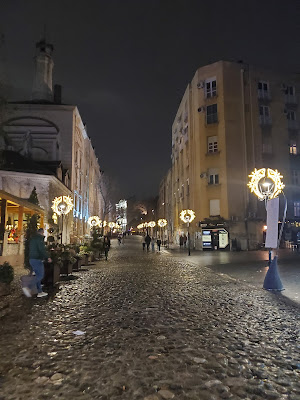Yesterday morning, Diana flew from Sofia to Amsterdam and onward to Edmonton. But I continued overland, first by bus from Sofia across the border into Serbia and to Nis, Serbia's major southern city, and then by train to Belgrade. I arrived in the evening in Belgrade's brand new central station, which is on the southern outskirts of the city centre.
I caught a bus into the city centre, and then walked a couple of blocks to my hotel, the surprisingly affordable Hotel Balkan.
My room is small, but perfect for me, and I am staying here two nights.
The main floor cafe is one of the real highlights of this hotel!
I enjoyed a glass of slivovitz there this evening.
My hotel is just across the street from Belgrade's famous (and much more expensive) Hotel Moskva.
But, those photos were all taken today. Last night, after checking in, I went out for a walk and to get some dinner.
Some of the graffiti regarding Serbia's relationship to Kosovo caught my eye.
This one apparently translates "when the army returns to Kosovo." Yikes! The graffiti has been there since summer, I read, so evidently city authorities do not consider it an issue.
Today is Sunday and the city was sleepy when I headed out. I needed to do laundry, and found a laundromat down the street. After throwing in my wash, I went for a walk, past the National Assembly . .
. . . St. Mark's church, which is Serbian Orthodox . . .
. . . Holy Trinity church, which is Russian Orthodox . . .
. . . and to what I was particularly interested in seeing, the former Radio Television Serbia (RTS) headquarters, which NATO targeted with a missile strike in 1999. Twenty-five years later, Belgrade has left this as is. The hit remains very controversial, both in terms of the legitimacy of the building as a target of a military strike, and internally to Serbia, where there is evidence senior people knew the strike was coming but failed to evacuate the building where junior staff were working that night (some of whom died).
RTS is now headquartered next door, by the way.
On my way back to the laundromat I walked a different route past the Post Office (how impressive is that!) . . .
. . . the presidential palace . . .
. . . Belgrade's city hall . . .
. . . and the Monument to Tsar Nicholas II Romanov.
I changed the laundry over to the dryer and went back out, this time down to the old train station . . .
. . . where there is a massive statue of Stefan Nemanja, a man who lived almost 900 years ago and is remembered as the founder of Serbia and the Serbian Orthodox Church.
Clean laundry loaded into my backpack, I went back to the hotel to drop it off. The city seemed to be waking up (and warming up) now as it was 10:30. I wanted to go to the New Belgrade train station (not to be confused with the new Central Station) across the Sava River in New Belgrade to plan my onward journey for tomorrow. So, I caught a bus across the river and through New Belgrade to the station, where I was able to buy my train ticket and figure out where I would need to be tomorrow morning.
I caught the bus back over the Sava River, but I got off at the first stop once we crossed the bridge.
From here I walked up the hill into the old city.
I went past the Cathedral Church of Saint Michael the Archangel . . .
. . . and then walked into Kalemegdan Park . . .
. . . which is where Kalemegdan Fortress sits on top of the hill . . .
. . . overlooking the confluence of the Sava and Danube Rivers.
After visiting the park, and then walking back to the hotel down the Kneza Mihaila pedestrian street, I jumped on a bus to go to a traditional Serbian restaurant I found online to get a nice warm lunch.
By the way, I have loved Belgrade's transit system. You buy your fare on an app and so there is no paying on the bus or tapping in and out or anything. Moreover, even on a Sunday the buses are frequent and routes seem intuitive.
After lunch I walked just a few blocks away to the massive Church of Saint Sava. Construction began on this church in 1935, when Belgarde was the capital of a very different country. During World War 2 the incomplete building was used by both the German army and Tito's partisans, and then it sat until 1984, when the Orthodox Church was finally given permission to resume construction. Twenty years later, in 2004, it was consecrated, and only the in last few years is it considered to be actually completed. It is the largest church in Serbia and one of the largest churches in the world, although smaller than Istanbul's Aya Sofya, which it is modeled after.
The mosaics inside are quite remarkable, and interestingly were heavily financed by Russia.
There are prayers on the outer doors in a variety of different languages, including English and Hebrew and Arabic.
As I walked away from the church an accordion busker was playing, and I found the atmosphere idyllic.
















































No comments:
Post a Comment